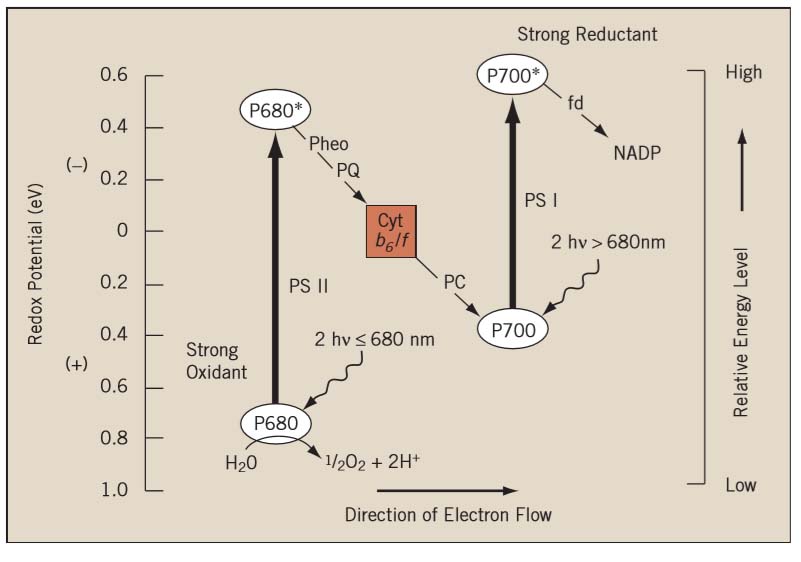Electron transport actually begins with the arrival of excitation energy at the photosystem II reaction center chlorophyll, P680, which is located near the lumenal side of the reaction center.
As a consequence of this initial endergonic excitation process, P680* can rapidly (within picoseconds, 10−12 s) transfer electrons exergonically to pheophytin(Pheo).
Pheophytin considered the primary electron acceptor in PSII, is a form of chlorophyll a in which the magnesium ion has been replaced by two hydrogens.
Since this initial oxidation of P680 is light dependent, this is called a photooxidation, which results in the formation of P680+ and Pheo−,a charge separation.
Note that the energy of one photon results in the release of one electron.
This charge separation effectively stores light energy as redox potential energy and represents the actual conversion of light energy to chemical energy.
The electron is passed from QA to plastoquinone(PQ), resulting in the formation of [P680+ Pheo QA].
P680+ is a very strong oxidant (perhaps the strongest known in biological systems) and is able to ‘‘extract’’ electrons from water.
Oxygen-evolving complex (OEC)
The electrons that reduce P680+ are most immediately supplied by a cluster of four manganese ions associated with a small complex of proteins called the oxygen-evolving complex (OEC). As the name implies, the OEC is responsible for the splitting (oxidation) of water and the consequent evolution of molecular oxygen. The OEC is located on the lumen side of the thylakoid membrane
2H2O ———————> O2 +4H++4e
THE CYTOCHROME COMPLEX
This is another multiprotein, membrane-spanning redox complex whose principal constituents are cytochrome b6 (Cytb6) and cytochrome f (Cyt f).
Plastocyanin
From Cyt f, the electrons are picked up by a copper-binding protein, plastocyanin (PC). PC is a small peripheral protein that is able to diffuse freely along the lumenal surface of the thylakoid membrane.
Excitation of P700 (PSI)
With the absorption of light energy chlorophyll molecules at PS-I also excited.
As a consequence of this initial endergonic excitation, P700* is rapidly photooxidized to P700+ by the primary electron acceptor (A) in PSI, a molecule of chlorophyll a
the electron is then passed through a quinone and additional FeS centers and finally, on the stroma side of the membrane, to ferredoxin. Ferredoxin is another FeS-protein that is soluble in the stroma.
Ferredoxin in turn is used to reduce NADP+, a reaction mediated by the enzyme ferredoxin-NADP+-oxidoreductase. Finally, the electron deficiency in P700+ is satisfied by withdrawing an electron from reduced PC.
The overall effect of the complete electron transport scheme is to establish a continuous flow of electrons between water and NADP+, passing through the two separate photosystems and the intervening cytochrome complex.

PHOTOPHOSPHORYLATION IS THE LIGHT-DEPENDENT SYNTHESIS OF ATP
Light-driven production of ATP by chloroplasts is known as photo phosphorylation.
Click here for Cyclic, non-cyclic photophosphorylation and Chemiosmosis